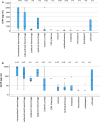GFAP point-of-care measurement for prehospital diagnosis of intracranial hemorrhage in acute coma
- PMID: 38581002
- PMCID: PMC10996105
- DOI: 10.1186/s13054-024-04892-5
GFAP point-of-care measurement for prehospital diagnosis of intracranial hemorrhage in acute coma
Abstract
Background: Prehospital triage and treatment of patients with acute coma is challenging for rescue services, as the underlying pathological conditions are highly heterogenous. Recently, glial fibrillary acidic protein (GFAP) has been identified as a biomarker of intracranial hemorrhage. The aim of this prospective study was to test whether prehospital GFAP measurements on a point-of-care device have the potential to rapidly differentiate intracranial hemorrhage from other causes of acute coma.
Methods: This study was conducted at the RKH Klinikum Ludwigsburg, a tertiary care hospital in the northern vicinity of Stuttgart, Germany. Patients who were admitted to the emergency department with the prehospital diagnosis of acute coma (Glasgow Coma Scale scores between 3 and 8) were enrolled prospectively. Blood samples were collected in the prehospital phase. Plasma GFAP measurements were performed on the i-STAT Alinity® (Abbott) device (duration of analysis 15 min) shortly after hospital admission.
Results: 143 patients were enrolled (mean age 65 ± 20 years, 42.7% female). GFAP plasma concentrations were strongly elevated in patients with intracranial hemorrhage (n = 51) compared to all other coma etiologies (3352 pg/mL [IQR 613-10001] vs. 43 pg/mL [IQR 29-91.25], p < 0.001). When using an optimal cut-off value of 101 pg/mL, sensitivity for identifying intracranial hemorrhage was 94.1% (specificity 78.9%, positive predictive value 71.6%, negative predictive value 95.9%). In-hospital mortality risk was associated with prehospital GFAP values.
Conclusion: Increased GFAP plasma concentrations in patients with acute coma identify intracranial hemorrhage with high diagnostic accuracy. Prehospital GFAP measurements on a point-of-care platform allow rapid stratification according to the underlying cause of coma by rescue services. This could have major impact on triage and management of these critically ill patients.
Keywords: Biomarker; Coma; Diagnostics; GFAP; Glial fibrillary acidic protein.
© 2024. The Author(s).
Conflict of interest statement
Prof. Foerch invented the following patent: Use of GFAP for identification of intracerebral hemorrhage (US20150247867). The other authors report no conflicts of interest.
Figures




References
-
- van Rein EAJ, van der Sluijs R, Houwert RM, Gunning AC, Lichtveld RA, Leenen LPH, van Heijl M. Effectiveness of prehospital trauma triage systems in selecting severely injured patients: Is comparative analysis possible? Am J Emerg Med. 2018;36:1060–1069. doi: 10.1016/j.ajem.2018.01.055. - DOI - PubMed
Publication types
MeSH terms
Substances
LinkOut - more resources
Full Text Sources
Medical
Miscellaneous

